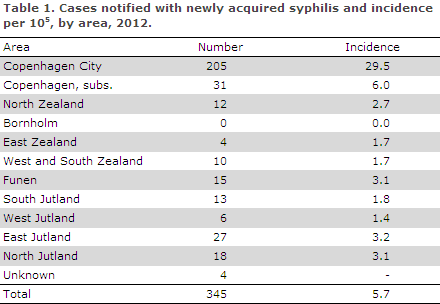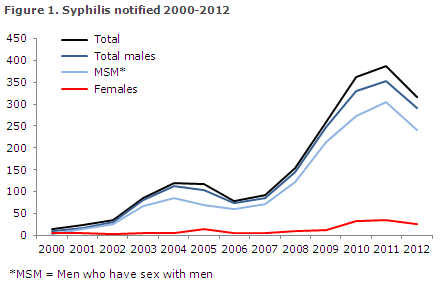No 34 - 2013
Syphilis 2012
Syphilis 2012
2012 saw 345 notifications of newly acquired syphilis in 342 persons. A total of 317 (92%) were male and 28 (8%) were female cases. The median age for females was 31 years (range 19-65 years), and for males 38 years (range 17-81 years).
The majority resided in the Copenhagen area, Table 1.

The majority, 278 (81%) of the notified cases were Danish-born persons, whereas 55 (16%) were immigrants, eight (2%) were second-generation immigrants and four (1%) were tourists.
A total of 316 (92%) of the cases were notified to the Notification System for Infectious Diseases (NSID), the Department of Infectious Disease Epidemiology (DIDE). In 298 (86%) of the 345 cases, a specimen had been submitted to the Department of Microbiological Diagnostics and Virology (DMDV), SSI, and the case had been notified to the NSID, DIDE.
In 29 (9%) of the cases, a specimen had been submitted to the DMDV only and in 18 (5%) cases infection had only been notified to the NSID.
The number of notified syphilis cases has decreased since 2011, Figure 1. The decrease was observed in all parts of Denmark apart from the City of Copenhagen, where the number of cases increased slightly (from 200 to 205, EPI-NEWS 37/12).

Syphilis diagnostics
Among the 327 cases in which specimens were submitted to the DMDV, 259 (79%) were detected by serology, 60 (18%) by serology as well as PCR, and eight (3%) cases were detected by PCR exclusively.
Congenital syphilis
No cases of congenital syphilis were notified during 2012. Syphilis antibodies were detected in seven neonates whose mothers had been diagnosed as syphilis positives in the pregnancy screening. In all seven cases, only maternal antibodies were detected. Nevertheless, treatment was performed in two of the children as the mothers had received treatment so late in the course of the pregnancy that full treatment effect could not be guaranteed.
Transmission
The 316 cases that were notified to the DIDE occurred in a total of 313 persons, as one male had experienced two syphilis episodes during the year and another male had experienced three episodes. Among these 313 persons, 25 were heterosexually infected females (8% of all notified persons), 44 were heterosexually infected males (15% of the notified males), 237 were men who have sex with men (MSM) (82% of the notified males) and seven were males whose route of infection was unknown (2% of the notified males), Figure 1.
The country of infection was stated for 265 (85%) of the notified cases, 21 females and 242 males. Among males, a total of 214 (88%) were infected in Denmark, and among females the corresponding number was 22 (96%). Among heterosexually infected males, 29 (80%) were infected in Denmark, while this was the case for 182 (90%) of MSM.
Syphilis and HIV
Information on HIV status was available for 267 males (96% of MSM and 77% of heterosexually infected males), and for 22 (89%) females.
Among HIV-tested males, 103 (39%) were HIV positives. A total of 94 HIV positives were detected among 227 MSM (41%), eight HIV positives were found among 34 heterosexually infected males, and the mode of infection was unknown for the last HIV positive male. One non-Danish female was HIV positive.
Commentary
The increase in the incidence of syphilis which had characterised the previous five years did not continue through 2012. Various efforts have been made with a view to raise awareness about the testing and management of syphilis − not least the regular testing of HIV-positive patients by the infectious medicine departments, and in 2012 confirmatory syphilis diagnostics had not yet been taken home by the Danish Regions.
On that basis it is presumed that the SSI has recorded most cases. Consequently, the observed decrease seems to reflect a real reduction in the number of new cases. This assumption is further supported by the fact that the decrease was observed in all parts of Denmark, except for Copenhagen.
As temporary upwards or downwards trends are frequent, it is, however, too early to assess if the increasing trend has been turned around or if the temporary decrease will be replaced by another increase as observed in 2006 relative to 2005. Preliminary numbers for 2013 do not indicate a major increase in 2013.
In Denmark, syphilis continues to occur primarily among MSM, and − in contrast to gonorrhoea − no substantial increase has been seen in the number of cases among heterosexually infected persons.
No cases of congenital syphilis were notified in 2012, which is probably owed to well-functioning pregnancy screening, which, on average, has yielded 6-9 cases annually among pregnant women since the (re)introduction of syphilis screening in 2010, EPI-NEWS 22/13.
Syphilis is a marker for unprotected sex, and therefore also a marker for the risk of HIV infection and infection with other sexually transmitted diseases. It is therefore still important that MSM who are tested for syphilis also be tested for HIV (EPI-NEWS 46/09), lymphogranuloma venereum (LGV), hepatitis B & C, and gonorrhoea.
PCR testing is expedient for detection of Treponema pallidum in chancre material and is often positive before antibodies can be detected. Correct diagnosis and staging are important for the treatment of the individual syphilis patient as well as for monitoring efforts.
Tentative diagnoses based on positive screening results should therefore be verified trough extended serological tests.
Newly acquired syphilis, i.e. primary and secondary syphilis, is notified to the Department of Infectious Disease Epidemiology, Statens Serum Institut (SSI) on Form 1510.
(B. Søborg, S. Cowan, the Department of Infectious Disease Epidemiology, S. Hoffmann, Microbiology and Infection Control)
Link to previous issues of EPI-NEWS
21 August 2013